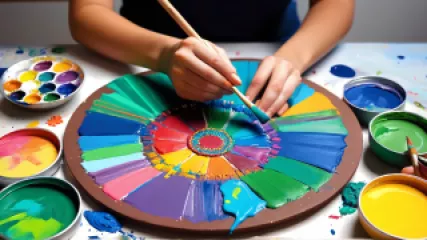The Ultimate Guide to Healing Through Art
The Ultimate Guide to Healing Through Art
Art has long been a powerful tool for healing, self-expression, and personal growth. Whether you're struggling with mental health challenges, seeking to process grief or trauma, or simply looking to tap into your innate creativity, the benefits of art therapy are numerous and well-documented. In this comprehensive guide, we'll explore the transformative power of art as a therapeutic modality, diving into the various techniques, approaches, and real-world applications that can help you unlock your inner healing potential.
The Roots of Art Therapy
Art therapy is a form of expressive therapy that uses the creative process of making art to improve a person's physical, mental, and emotional well-being. The roots of this practice can be traced back to the early 20th century, when pioneers in the field, such as Margaret Naumburg and Edith Kramer, began to recognize the inherent therapeutic value of artistic expression.
These early practitioners observed that the act of creating art, whether it be painting, drawing, sculpture, or any other medium, could help individuals better understand and communicate their inner experiences, emotions, and struggles. By tapping into the subconscious and allowing the creative process to unfold, art therapy provided a safe and non-threatening avenue for self-exploration, self-discovery, and personal growth.
The Science Behind Art Therapy
The therapeutic benefits of art have been extensively researched and documented over the past several decades. Studies have shown that engaging in art-making can have a profound impact on both physical and mental health, triggering a range of positive physiological and psychological responses.
On a neurological level, the act of creating art has been linked to increased activity in the prefrontal cortex, the region of the brain responsible for problem-solving, decision-making, and emotional regulation. Additionally, art-making has been shown to stimulate the release of neurotransmitters such as dopamine and serotonin, which can help alleviate symptoms of depression, anxiety, and stress.
From a psychological perspective, art therapy provides a means of self-expression and emotional processing that can be particularly beneficial for individuals who may struggle with verbal communication or have difficulty accessing their inner experiences. The creative process can serve as a bridge between the conscious and unconscious mind, allowing for the expression of thoughts, feelings, and experiences that may be difficult to articulate through conventional means.
The Therapeutic Modalities of Art Therapy
Art therapy encompasses a wide range of creative modalities, each with its own unique benefits and applications. Some of the most common art therapy techniques include:
Painting and Drawing
The use of paint, colored pencils, markers, and other drawing materials can be a powerful tool for self-expression, emotional exploration, and stress relief. Through the act of mark-making, individuals can tap into their inner experiences, work through complex emotions, and explore their personal narratives.
Collage and Mixed Media
The process of creating collages or mixed-media artworks can be particularly useful for individuals who may struggle with verbal expression or have difficulty accessing their emotions. By arranging and combining various found materials, textures, and images, individuals can create visual representations of their inner experiences, feelings, and perspectives.
Sculpture and Clay Work
The tactile and three-dimensional nature of sculpture and clay work can be particularly beneficial for individuals seeking to explore and process physical experiences, sensations, and embodied memories. The act of manipulating and shaping materials can provide a tangible outlet for emotional expression and facilitate the integration of mind and body.
Mandala Creation
The creation of mandalas, intricate circular designs often associated with Eastern spiritual traditions, can be a powerful tool for meditation, self-reflection, and symbolic exploration. The process of creating a mandala can help individuals access their inner wisdom, find balance and harmony, and gain a deeper understanding of their emotional and psychological experiences.
Journaling and Bookmaking
The practice of art journaling, where individuals combine written expression with visual elements, can be a valuable avenue for self-exploration, emotional processing, and personal growth. The act of creating handmade books or journals can also be a means of self-care, allowing individuals to curate and preserve their creative experiences.
The Benefits of Art Therapy
The use of art as a therapeutic modality has been shown to offer a wide range of benefits for individuals of all ages and backgrounds. Some of the key benefits of art therapy include:
Improved Emotional Regulation
The creative process can serve as a conduit for the expression and processing of difficult emotions, helping individuals to better understand, manage, and ultimately overcome feelings of anxiety, depression, anger, and grief.
Enhanced Self-Awareness and Insight
By engaging in art-making, individuals can gain a deeper understanding of their inner experiences, personal narratives, and subconscious thought patterns, leading to increased self-awareness and a greater capacity for personal growth and transformation.
Stress Reduction and Relaxation
The act of creating art has been shown to lower cortisol levels, the primary hormone associated with stress, and promote a state of relaxation and focus, which can be particularly beneficial for individuals dealing with high levels of stress or burnout.
Improved Communication and Interpersonal Relationships
Art therapy can provide a non-verbal means of self-expression, helping individuals to communicate their thoughts, feelings, and experiences in ways that may be difficult to articulate through traditional verbal communication. This can be particularly beneficial for those struggling with social anxiety, communication challenges, or interpersonal conflicts.
Increased Resilience and Coping Strategies
The process of creating art can help individuals develop a greater sense of personal agency, self-efficacy, and resilience in the face of life's challenges. By tapping into their innate creativity and problem-solving skills, individuals can cultivate a range of effective coping mechanisms and strategies for navigating difficult emotions and experiences.
Incorporating Art Therapy into Your Life
Whether you're seeking to address specific mental health concerns or simply looking to tap into your creative potential, incorporating art therapy into your life can be a powerful and transformative experience. Here are some tips for getting started:
Explore Different Art Modalities
Experiment with a variety of art-making techniques, such as painting, drawing, collage, or sculpture, to discover which mediums resonate most with you. Don't be afraid to try new things and step outside your comfort zone – the process of exploration can be just as rewarding as the final product.
Set Aside Dedicated Time for Art-Making
Make a conscious effort to carve out time in your daily or weekly routine for art therapy sessions. Whether it's 15 minutes a day or a few hours on the weekend, the act of setting aside dedicated time for creative expression can be a powerful act of self-care and personal growth.
Engage with a Qualified Art Therapist
While art therapy can be a valuable and empowering practice for individuals to explore on their own, working with a qualified art therapist can provide valuable guidance, support, and clinical expertise. A trained art therapist can help you develop personalized strategies for using art as a means of healing and personal transformation.
Embrace the Process, Not the Product
It's important to remember that the true value of art therapy lies in the creative process, not the final product. Rather than focusing on creating a "perfect" or "aesthetically pleasing" work of art, try to immerse yourself in the act of creating, allowing the process to unfold organically and without judgement.
Reflect and Integrate Your Experiences
After each art therapy session, take some time to reflect on your experience, the emotions and insights that surfaced, and how you might be able to integrate those learnings into your daily life. Journaling, discussion with a therapist, or simply quiet contemplation can all be valuable tools for this process of reflection and integration.
Inspiring Stories of Healing Through Art
Throughout history, countless individuals have turned to art as a means of healing, self-expression, and personal growth. Here are just a few examples of how the power of art therapy has transformed lives:
Manuel Greene: Finding Solace in the Brushstrokes
After a devastating car accident left him with chronic pain and a traumatic brain injury, Manuel Greene struggled to find a way to cope with the physical and emotional toll of his condition. It wasn't until he discovered the healing power of painting that he began to find solace and a renewed sense of purpose. "With each brushstroke, I could feel the weight of my experiences start to lift," Manuel shared. "The act of creating art became a lifeline, a way for me to process my emotions and reclaim a sense of control over my life."Manuel Greene, Art Therapy Client
Sydney Howard: Art as a Coping Mechanism for Grief
When Sydney Howard's partner passed away suddenly, she found herself overwhelmed by the intensity of her grief. Turning to art therapy as a means of coping, Sydney began creating collages that served as visual representations of her emotional journey. "The process of cutting, tearing, and arranging the images allowed me to give shape to the chaos I was feeling inside," Sydney recalled. "It was a way for me to honor my loss and gradually work through the pain in a way that felt both cathartic and empowering."Sydney Howard, Art Therapy Client
Delilah Scott: Art Therapy as a Path to Self-Discovery
For Delilah Scott, art therapy was not just a tool for healing, but a means of self-discovery and personal growth. Struggling with issues of identity and self-esteem, Delilah found that the process of creating art allowed her to explore and express aspects of herself that she had long kept hidden. "Through the act of making art, I was able to access parts of myself that I had been afraid to confront," Delilah shared. "It was a deeply transformative experience that helped me to embrace my true self and cultivate a greater sense of self-love and acceptance."Delilah Scott, Art Therapy Client
Jason Freeman: Art Therapy as a Pathway to Mental Health Recovery
For Jason Freeman, a young man grappling with the challenges of mental illness, art therapy provided a crucial avenue for healing and recovery. "When the weight of my depression and anxiety felt overwhelming, the act of creating art gave me a sense of control and purpose," Jason reflected. "It was a way for me to externalize my inner experiences, work through difficult emotions, and ultimately, find a greater sense of balance and peace within myself."Jason Freeman, Art Therapy Client
Conclusion: Embracing the Transformative Power of Art Therapy
In the end, the healing power of art therapy lies in its ability to transcend the boundaries of traditional mental health interventions, offering a deeply personal and profoundly transformative means of self-exploration, emotional processing, and personal growth.
Whether you're seeking to address specific mental health concerns, explore your creative potential, or simply find a way to nurture your overall well-being, the practice of art therapy can provide a powerful and enriching pathway to healing and self-discovery.
So, embrace the transformative power of art, and embark on a journey of self-expression, personal growth, and creative fulfillment. The possibilities for healing and transformation are limitless.






